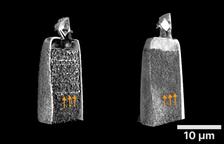3D representation of the gold structure based on the dark field images (left) and the attenuation images (right). The dark field images make it easy to recognise irregularities in the inner structure (marked with orange arrows) that would otherwise remain hidden. (Credit: Hereon/ Sami Wirtensohn)
X-ray microscopes are essential for examining components and materials because they can be used to detect changes and details in the material. Until now, however, it has been difficult to detect small cracks or tiny inclusions in the images. By developing a new method, researchers at the Helmholtz-Zentrum Hereon are now able to visualise such changes in the nanometre regime.The experiments were performed at the PETRA III beamline P05 at DESY, operated by the Hereon. In particular, materials research and quality assurance will profit from this development.
The quality must be right. This also applies to materials science. When metal parts are welded together, you need to know whether the weld seam is any good - or whether small cracks or pores have formed inside which could lead to failure. High-performance materials, e.g. for electrodes in electric car batteries or fuel cells, should not contain defects to allow the current to flow undisturbed.
In order to better understand the effects of changes in materials and to detect possible defects, X-rays have already been used for a long time to visualise defects in materials. In conventional X-ray images, structures are made visible through the attenuation of X-rays. However, this is often not sufficient to detect very small or low-density structures.
The researchers Sami Wirtensohn and Silja Flenner from Imke Greving's group at Hereon, together with researchers from TU München and PSI in Villigen (Switzerland), have now succeeded in making such small structures visible in the nanometre range, using a new method. Unlike a conventional X-ray image, they do not use the attenuated light itself but rather the light scattered by the object being X-rayed which is deflected in different directions. “Nanometre-sized structures such as tiny cracks scatter the light - and this scattering can be seen,” explains Sami Wirtensohn, first author of the study. This makes details and structures visible that are normally difficult or impossible to see. The special feature: “The method can even make structures visible that are below the resolution of the X-ray microscope,” explains Silja Flenner, who initiated the project.
The challenge with the new approach has been that the researchers had to suppress the attenuated light of the object to a certain extent so that the scattering image would become visible. In X-ray microscopy, they therefore use optics that redirect the X-ray light so that the rays follow a known pattern. These X-ray beams can then be blocked by installing apertures. The scattered light, on the other hand, changes its direction when penetrating the sample and can pass by the apertures. This results in the so-called dark field image, for the first time with nanometere resolution. “This gives us an image in which the nanostructures are very clearly visible due to the scattering,” says Sami Wirtensohn.
For materials research, this is a gain with little effort. “For the first time, a practical method for dark-field imaging is available that can be easily implemented in an X-ray microscope,” says Imke Greving, who is leading the X-ray microscopy team at the Hereon imaging PETRA III beamline P05. Such X-ray microscopes are operated at synchrotron radiation sources, of which there are only a few dozen worldwide. These could easily be retrofitted with an aperture to enable dark-field microscopy. This would be worthwhile because companies or materials researchers would be able to search for tiny defects and flaws in materials much better in future. The research team around Sami Wirtensohn has reported on their development in the scientific journal Optica.
(partly from Hereon News)
Reference:
"Nanoscale dark-field imaging in full-field transmission X-ray microscopy": Sami Wirtensohn, Peng Qi, Christian David, Julia Herzen, Imke Greving, and Silja Flenner, Optica, (2024), DOI: 10.1364/OPTICA.524812







